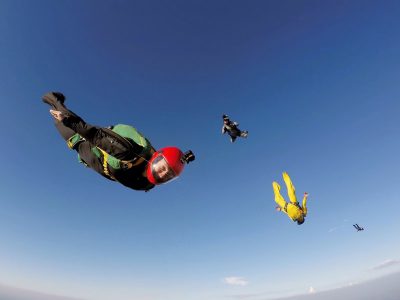As you may be aware, there are different disciplines practiced within the sport of skydiving, including wingsuiting, relative work, free-flying, and canopy piloting. But what is a discipline in skydiving without its very own special maneuvers? If you’re curious about how sport skydivers accomplish the amazing skydiving maneuvers you see in videos, you’ll want to check out this list of skydiving terms that are well-known in the industry, but not so much to the outside world.
Ready for an insider peek? Here we go.
Accuracy Landing
Landing with accuracy is a goal all skydivers strive to achieve. Those who practice Accuracy Landing as a discipline, though, take it an extreme. This discipline requires participants to land on a target about the size of a coin!
Arching & De-Arching
 What is the “banana position” in skydiving? It’s the arch you hear skydivers talk about all the time! On a beginner-level belly jump, you learn that to fall faster you arch the body, and to fall slower you de-arch the body.
What is the “banana position” in skydiving? It’s the arch you hear skydivers talk about all the time! On a beginner-level belly jump, you learn that to fall faster you arch the body, and to fall slower you de-arch the body.
Back Flying
To fly with your back toward the earth rather than the standard belly-to-earth orientation, you simply turn your body so that your back is facing the ground. Generally, you’ll have other skydivers around you to orient yourself to fly in the right direction.
Belly Flying
Belly flying might be the first skydiving maneuver ever invented, and it remains the first body position you learn as a skydiving student. To belly fly, you fall in an arched position with your belly button pointing down at the ground. As a discipline in and of itself, belly flying has a couple of pseudonyms, including Relative Work or RW, and Formation Skydiving or FS.
Faster or Slower Falling
More surface area presented to the ground means a slower fall rate; less results in a faster fall rate. Wingsuits, which present a lot of surface area more-or-less parallel to the ground, fall very slowly. Speed skydivers, however, point just the crown of their head at the ground, like a lawn dart, and can reach speeds of up to 300 mph!
Forward & Backward Movement
Depending on the discipline (and your intended general body position), you present different surface areas to the relative wind, which moves you backward and forward. As is true of all movement in the sky, make sure you know the relative position of other jumpers before executing any maneuvers.
Head Down
 The holy grail for newer skydivers working toward the freefly discipline requires participants to master head-down flight. And it’s just as it sounds: flying upside-down through the sky! You can fly with your head pointed downward in a couple of ways. Static flight means you fly in one vertical line straight down through the sky. With Carving, you stretch out and make your body into a great big spinning fan blade. Fun, huh?
The holy grail for newer skydivers working toward the freefly discipline requires participants to master head-down flight. And it’s just as it sounds: flying upside-down through the sky! You can fly with your head pointed downward in a couple of ways. Static flight means you fly in one vertical line straight down through the sky. With Carving, you stretch out and make your body into a great big spinning fan blade. Fun, huh?
Sit Flying
Sit flying is also the body position of the freefly discipline. It’s another one of those skydiving maneuvers that’s just as it sounds: like sitting on a chair in the air. It’s a challenging maneuver to learn because it’s inherently unstable and easy to ping out of, but it serves as the gateway to considerably more challenging maneuvers in the discipline.
Swooping
What is a swooping maneuver in skydiving? A fast-moving parachute maneuver that some skydivers use when landing. You pick up speed in the air and dive your (small) canopy toward the ground at a steep angle, planing out at the very end to skim over the ground or, in some cases, over water. It’s super fun once you’ve got the hang of it but, because it’s performed so close to the ground at high speeds, it’s high risk. You’ll want to leave swooping on your “skydiving maneuvers wishlist” until you have adequate experience.
Turns
No matter what discipline you’re practicing in the sky, you can be sure turning your body is involved! Turning is a foundational skydiving maneuver that every sport skydiver learns as a fledgling student. To turn, you use the surface area of your arms, legs, and torso to change both the direction and the orientation of your body in the air.
Now that you’ve got some new vocabulary under your belt, you might be wondering what a high-risk maneuver is called. Some would say swooping is the top high-risk maneuver, but the fact is that all skydiving maneuvers are high-risk if performed without a conservative approach and extensive professional coaching.
Want a front-row seat to some of these skydiving maneuvers or, better yet, take the leap and start your own skydiving journey? Visit Skydive Monroe and jump with us! There’s no better classroom than the sky!
Copyright © 2025, Skydive Monroe, All Rights Reserved.
DropZone Web Design & Marketing by Beyond Marketing, LLC



